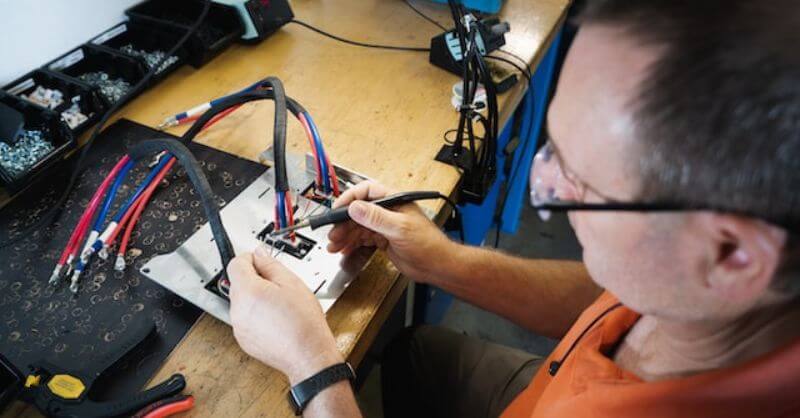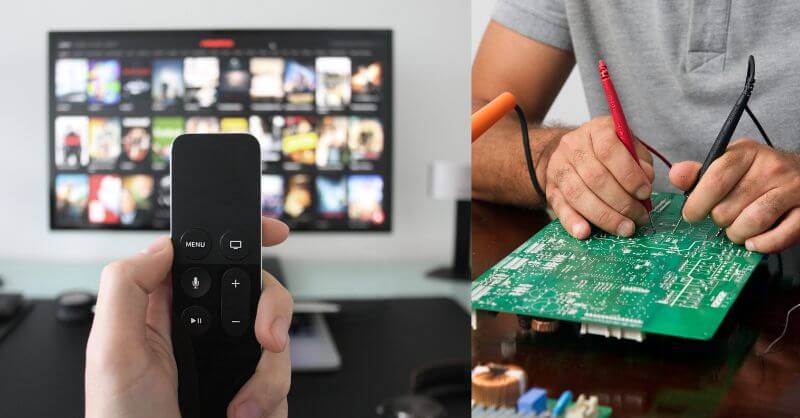Like any electronic device, TVs can encounter issues that require repairs. Whether it’s a minor glitch or a major problem, understanding the potential costs of TV repairs is essential for consumers.
The cost to fix a TV is range anywhere from $20 to $1000+ depending on the issues.
In this article, we will explore the factors that increase TV repair costs and discuss whether repairing your TV is a viable option compared to replacement.
Table of Contents
The Most Common TV Problems You Faced
Before diving into the costs, let’s explore some common TV problems that users might encounter:
- No Picture or Sound: The TV displays a blank screen with no audio output.
- Flickering or Distorted Picture: The screen exhibits flickering, unusual colors, or distorted images.
- Remote Control Issues: The remote doesn’t work properly, leading to difficulties in controlling the TV.
- Unresponsive Buttons: The TV’s physical buttons, such as power or volume, do not respond.
- Power Cycling: The TV turns on and off repeatedly on its own.
- Audio Problems: The TV produces no sound, or the audio is distorted, muffled, or too quiet.
- Poor Reception or No Channels: The TV can’t pick up channels properly, or there’s no signal reception.
- Pixelation: The screen displays blocky or pixelated images, often seen in digital broadcasts.
- Screen Glare or Reflections: External light sources cause glare or reflections on the screen, affecting visibility.
- Burn-In or Image Retention: Persistent static images can cause ghosting or burn-in on the screen.
- HDMI or Connectivity Issues: Problems with connecting devices through HDMI ports or other interfaces.
- Overheating: The TV gets unusually hot, potentially leading to performance issues.
- Software Freezes or Crashes: The TV’s software becomes unresponsive or crashes frequently.
- Network Connectivity Problems: Issues with connecting the TV to Wi-Fi or using online features.
- Lines, Bars, or Patterns: Visible lines, bars, or patterns appear on the screen, affecting viewing quality.
- Remote Pairing Problems: Difficulties in pairing or syncing the remote control with the TV.
- Power Supply Issues: The TV doesn’t power on or remains in standby mode.
- Lack of Tuner Functionality: Problems with the built-in tuner, preventing channel tuning or scanning.
- Speakers Not Working: The TV’s built-in speakers produce no sound or distorted audio.
- Slow Performance: The TV’s menus, apps, or functions respond sluggishly.
- Color Problems: The TV displays incorrect colors or a lack of color accuracy.
- External Device Compatibility: Difficulties in connecting and using external devices like gaming consoles or Blu-ray players.
- Physical Damage: Cracked screen, broken bezels, or other physical damage affecting functionality.
- Auto Brightness Issues: The TV’s brightness adjusts unexpectedly or doesn’t respond to changes.
- Remote Sensor Problems: The TV doesn’t register remote control signals consistently.

DIY Troubleshooting TV Tips
Sometimes, you can fix minor TV issues yourself. Here are some DIY troubleshooting tips:
Checking Power Source
Ensure that the power source is functioning correctly by plugging another device into the same outlet. If there’s no power, check the circuit breaker.
Checking Connections
Inspect all cable connections to ensure they are secure. Loose cables can lead to no picture or sound issues.
Adjusting Picture Settings
Experiment with picture settings to see if the issue is related to brightness, contrast, or other display options.
Testing Sound Settings
Check the TV’s audio settings to ensure they are not muted or set to an extremely low volume.
Replacing Batteries in Remote

If the remote control isn’t working, try replacing the batteries before assuming it’s defective.
Signs Your TV Needs Professional Repair
- No Picture or Sound: If your TV shows no picture or sound, even when it’s turned on, it could indicate a serious issue that requires professional attention.
- Flickering or Distorted Picture: If the screen flickers, shows weird colors, or has distorted images, it might be a problem that needs a technician’s expertise.
- Visible Cracks or Damage: Physical damage like cracks on the screen or visible external damage may affect the TV’s functionality and necessitate professional repair.
- Unresponsive to Remote: If the TV doesn’t respond to remote control commands, it might be due to internal problems that need fixing.
- Strange Noises: Unusual noises like buzzing, crackling, or popping sounds coming from the TV could indicate an internal issue requiring repair.
- Sudden Shut-Offs: If your TV unexpectedly turns off and won’t turn back on, it could be a sign of an underlying problem.
- Pixel Issues: Dead pixels (dots that remain a single color) or bright spots on the screen might require professional attention to fix.
- Software Glitches: If the TV’s menus, apps, or settings act up or freeze, it might need a technician’s help to resolve software problems.
- Persistent Lines or Patterns: If you notice lines, patterns, or bands on the screen that won’t go away, there might be a technical issue that needs fixing.
- Power Problems: If the TV won’t power on at all or if it’s turning off unexpectedly, it’s a clear sign of an issue that requires professional repair.
Read More: Cost to Fix a TV Screen?
Factors Affecting TV Repair Costs
The cost of repairing a TV can vary based on several factors:
TV Type and Size
Larger TVs, especially those with advanced technologies like OLED, may cost more to repair due to their intricate designs.
Warranty Coverage
If your TV is under warranty, some repairs might be covered, significantly reducing your out-of-pocket expenses.
Replacement Parts
The cost of replacement parts can vary based on the TV’s brand, model, and availability in the market.
Labor Costs
Repair costs often include labor charges, which can differ depending on the complexity of the repair.
Location and Service Provider
Geographical location can influence repair costs, with services in urban areas generally being more expensive.
Average Cost of Common TV Repairs
| TV Type | Common Issues | Average Repair Cost Range |
|---|---|---|
| LCD/LED TV | Backlight failure, screen flickering | $100 – $400 |
| Plasma TV | Burn-in, power supply issues | $200 – $600 |
| OLED TV | Screen burn-in, dead pixels | $300 – $1000+ |
| Smart TV | Software glitches, Wi-Fi connectivity | $150 – $600 |
| Projection TV | Blurry image, color issues | $100 – $600 |
Tips to Minimize TV Repair Costs
Here are some tips to help reduce the expenses associated with TV repairs:
- Regular Maintenance: Clean your TV regularly and ensure proper ventilation to prevent overheating and dust buildup.
- Extended Warranties: Consider purchasing an extended warranty to cover potential repairs beyond the standard warranty period.
- DIY Repairs for Simple Issues: For minor issues like remote control problems, try troubleshooting and fixing them yourself.
- Comparing Repair Quotes: Get quotes from multiple repair shops to find the best deal for your specific issue.
- Negotiating with Repair Technicians: In some cases, you might be able to negotiate the repair cost with the technician, especially for loyal customers.
TV Repair vs. Replacement
- Cost Considerations: Compare the cost of repairs with the price of a new TV to determine the most cost-effective option.
- TV Lifespan: Consider the age of your TV and its expected remaining lifespan before making a decision.
- Technological Advancements: Assess if repairing your current TV is worth it compared to the latest technology available in newer models.
- Environmental Impact: Choosing to repair your TV might reduce electronic waste and contribute to a more sustainable environment.
- Personal Preferences: Ultimately, your decision should align with your preferences and budget.
Conclusion
Repairing a TV can be a viable option in many cases, especially for minor issues or when the cost is significantly lower than a new TV.
However, for complex problems or older TVs nearing the end of their lifespan, replacement might be a better choice. Consider the factors we’ve discussed before making an informed decision.
FAQs
Can I fix a broken screen on my TV myself?
Fixing a broken screen is a complicated task best left to professionals due to the delicate nature of the components involved.
Is it worth repairing an old TV?
It depends on the extent of the damage and the cost of repairs. If the repairs are costly and your TV is outdated, replacing it might be a more practical choice.
How long does TV repair usually take?
The repair duration depends on the complexity of the issue and the availability of replacement parts. It can take anywhere from a few days to a couple of weeks.
Can software issues be fixed without professional help?
Minor software issues can often be resolved by users through firmware updates or factory resets. However, complex software problems should be handled by professionals.

